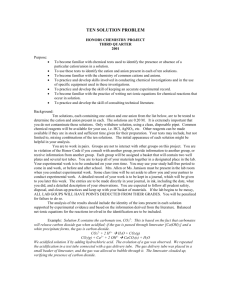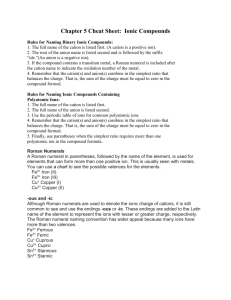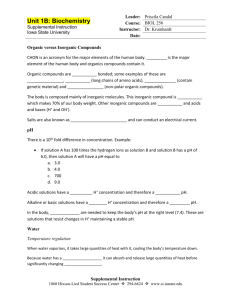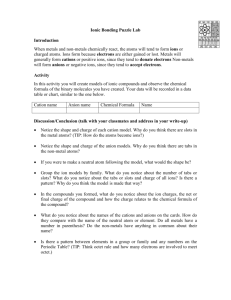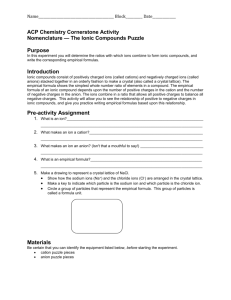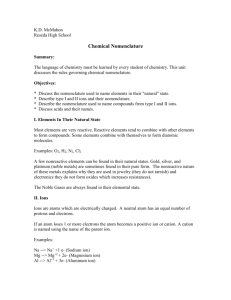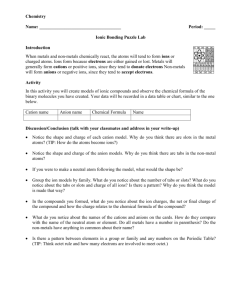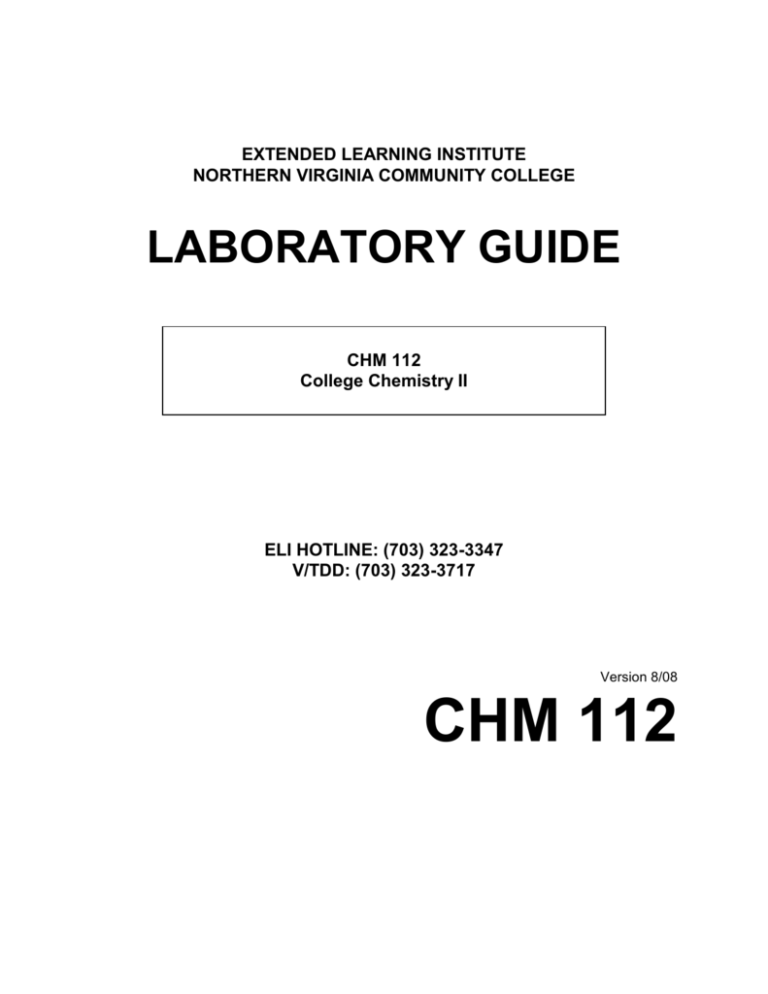
EXTENDED LEARNING INSTITUTE
NORTHERN VIRGINIA COMMUNITY COLLEGE
LABORATORY GUIDE
CHM 112
College Chemistry II
ELI HOTLINE: (703) 323-3347
V/TDD: (703) 323-3717
Version 8/08
CHM 112
Copyright © 2008 by Northern Virginia Community College. All rights reserved.
.
CHM 112 Laboratory Guide
Table of Contents
Overview of CHM 112 Laboratory Component ........................................................... 1
On-Campus Laboratory Experiments ............................................................... 1
Off-Campus Laboratory Exercises .................................................................... 2
Policies and Procedures for On-Campus Laboratories ............................................. 3
Off-Campus Laboratory Exercises .............................................................................. 5
Inorganic Nomenclature .................................................................................... 6
Kitchen Chemistry: Making Ice Cream ........................................................... 22
Introduction: Overview of CHM 112 Laboratory Component
The laboratory component of the ELI course CHM 112, College Chemistry II, consists of: three
on-campus laboratory experiments, one Nomenclature Lab and Test, and CyberChem CDROM CyberLabs. An additional Lab Safety, Orientation, and Techniques exercise is
required except for students who have completed CHM 111 through ELI or at the Annandale
campus.
On-campus laboratory experiments
The experiments are scheduled in the chemistry lab on Annandale Campus on Saturdays during
the semester. These are to be done in groups of four students. These experiments have been
selected from the Laboratory Manual for Principles of General Chemistry, 6th Edition. These
are:
1. Experiment 21: Molar Mass of a Solid -- read the textbook assignments for Unit 2
2. Experiment 35: Qual I -- read the sections on solubility and ionic reactions in textbook
Chapters 3 and 4; also read pages 840-844
3. Experiment 30: Molar Solubility; Common Ion Effect -- read the textbook
assignments for Unit 4
Complete the Prelaboratory Assignment questions in the Laboratory Manual for each
scheduled experiment individually, not in groups. Submit it to the instructor in Lab. Perform
each experiment and submit a Lab Report as per the described format. Allow three hours to
complete one experiment.
Preparation for first on-campus laboratory experiment
Before reporting to the Annandale Campus chemistry lab for the first time, you should:
a.
Complete Assignment 0 (see your online Course Guide) including your Course
Completion Plan on the online forum.
b.
Do the Lab Safety, Orientation, and Techniques off-campus lab (see instructions in the
Off-Campus Laboratory Exercises section on the next page).
c.
Read the “Procedures and Policies for On-Campus Laboratories” section of this Guide.
d.
you must take and pass the proctored online Lab Safety Quiz with a passing score of
16/20 or higher in any NOVA Testing Center. You may retake the quiz after a 2 hour
1
study period if necessary.
Students who have completed CHM 111 through ELI or at the Annandale Campus are exempted
from doing tasks b and d.
Off-campus Laboratory Experiments and Exercises
Mandatory Labs:
*
1.
2.
3.
4.
5.
6.
Lab Safety, Orientation, and Techniques -- Read Laboratory Safety and Guidelines,
Laboratory Data, and Laboratory Techniques and Dry Lab 1 (pages 1-42). Complete and
submit pages 35-36 and pages 41-42 stapled together.
(*Not required for students who have completed CHM 111 through ELI or at the
Annandale Campus).
Inorganic Nomenclature Lab and Nomenclature Test -- see the Instructions for OffCampus Laboratory Exercises section of this Laboratory Guide.
CyberLab 11: Phase Diagrams -- read textbook assignments for Unit 1.
CyberLab 13: Chemical Kinetics -- read textbook assignments for Unit 2. You must
perform the lab on three separate unknown samples.
Expt 26 (Lab manual) Prelab questions 1-7 and Postlab questions 2, 5, 6 --- Read
textbook assignments for Unit 3.
CyberLab 19: Electrochemistry -- read textbook assignments for Unit 5. You must
perform the lab on three separate unknown samples.
CyberLab 23: Nuclear Chemistry -- read textbook assignments for Unit 6. You must
perform the lab on three separate unknown samples
Complete instructions for all CyberLabs are found on the Cyber-Chem CD-ROMs. For the
CyberLabs, after performing each experiment submit a Lab Report using the format described in
the Procedures and Policies for On-Campus Laboratories section of this Laboratory Guide.
2
Procedures and Policies for On-Campus Laboratories
During the lab
-
Identify one member of your laboratory group to be the designated leader for the
experiment. This person will take the official set of data and observations during the lab
and coordinate the preparation of the lab report.
Each member of the group should record notes, observations and data on the Data Sheet
provided in the laboratory module. These data and observations are to be written in ink.
Follow all general laboratory safety rules and specific safety precautions and disposal
procedures for the experiment.
Have the instructor initial the official copies of all data and observations that will be
turned as part of the lab report.
-
NOTE: It is important that you follow the rule that all observations and data be recorded in
ink. These constitute an official and unchangeable record of the experiment. If there is
disagreement within the group concerning a measurement or observation, it must be repeated.
If the second determination differs from the original one, the original is crossed out with a
single line also in ink and the new value entered. A notation is added explaining why
repetition was necessary. It is essential that all observers agree on observation before it is
recorded, and that each member of a group assume responsibility for assuring that everyone
records the same data. If it is impossible to agree on an observation or measurement, even
after repeating it, the details of the argument are to be included as part of the observation so
they become part of the record.
Following the lab
Complete and submit a post-lab report 1 week after performing the experiment. One lab report
will be submitted by each group. The content of the report should include the following:
Cover page: Includes lab section, the names of the group members who performed the
experiment and contributed to the writing of the report; number and name of the experiment,
date performed, and date due.
Body of report -- This part of the report will contain:
An introduction stating the purpose of the lab exercise and a brief description of
procedures followed.
The "official" Data Sheet from the lab module exactly as completed during the
experiment.
A page or pages showing all calculations following rules for significant figures.
3
A concluding statement summarizing how the experimental results relate to the objective
of the experiment.
A statement from each individual group member describing his/her contribution to the
report.
If the lab experiment includes Post Laboratory Questions, these are to be completed by the group
working together and one copy attached to the lab report.
4
Instructions for Off-Campus Laboratory Exercises
for CHM 112-ELI
This section contains instructions for those CHM 112 ELI off-campus laboratory exercises which
are not CyberChem Labs as follows:
Mandatory Labs:
*Lab Safety, Orientation, and Techniques – From the Laboratory Manual for
Principles of General Chemistry, read the following: Laboratory Safety and
Guidelines, Laboratory Data, and Laboratory Techniques; Dry Lab 1; then complete
Sections A through D and submit pages 35-36 and pages 41-42 stapled together
(*Not required for students who have completed CHM 111 through ELI or at the
Annandale Campus)
Inorganic Nomenclature -- see page 6
Kitchen Chemistry -- Making Ice Cream -- see page 23
5
Inorganic Nomenclature
An Exercise in
Naming Chemical Compounds
and
Writing Chemical Formulas
Related material is covered in Chapter 2. View the lab video "Nomenclature" available at each of
the five campus libraries. Also read Dry Lab 2B, Inorganic Nomenclature II, and Dry Lab 2C,
Inorganic Nomenclature III.
Note: you must learn the Systematic Names. You are not responsible for knowing the trivial or
old system.
Your grade for this exercise will consist of the score earned on the Nomenclature Test you take
in the Testing Lab upon completion of the lab. Exercises contained in the lab need not be turned
in. However, you should complete them all. Be sure to check your responses against the
answers given at the end of the lab write-up.
In the Nomenclature Test you will be asked to identify compounds as ionic or covalent from their
names or formulas, to classify compounds as binary or ternary, to write formulas of compounds
given their names and to write names of compounds given their formulas. This last task is the
most difficult one of those listed. It would be well worth it to put extra effort into developing
this skill.
Any of the compounds or ions discussed in the lab handout may be included on the test.
6
INORGANIC NOMENCLATURE
1.
Introduction
Chemistry is divided into two main branches: organic chemistry and inorganic chemistry.
Organic chemistry is the study of carbon compounds, although some of these are included in the
study of inorganic chemistry. Among these compounds are carbon dioxide and its derivatives,
the carbonates, cyanides, carbon monoxide, and carbon disulfide.
Organic chemists deal with compounds which are relatively large. The properties of these
compounds depend on the spatial arrangement of the atoms within the molecules. Therefore, the
system of nomenclature used for organic chemistry must be detailed and complex.
Inorganic compounds, on the other hand, are commonly named by simply specifying the
proportions of the elements that make up the compound. The two branches of chemistry have
distinctly different but compatible systems of nomenclature, but the objective of both systems is
to name each compound in such a way that the chemical identity of the specific compound is
known with certainty.
A.
Nomenclature of Cations
Cations are formed when an atom loses one or more electrons. These ions will have a
positive electrical charge, and are normally formed from the atoms of metals.
A cation, if present, is always listed first in both names and formulas of compounds. These ions
have the same name as the elements from which they are derived, without any alteration. When
writing the symbol of a cation, the number of electrons lost in its formation is indicated by a
superscript Arabic numeral followed by a positive sign. (For those ions formed by losing one
electron, thus with a charge of positive one, the numeral 1 is commonly omitted.)
Na+
Ca2+
Examples:
"en ay positive"
"cee ay two positive"
Some elements, particularly those in the "d" block of the periodic table (transition elements) form
more than one cation. This is because the atom may, under different circumstances, lose a
different number of electrons. To name the cations of such an element, a system known as Stock
notation is preferred. A Roman numeral, representing the number of electrons lost and thus the
positive charge on the ion, is placed in parentheses immediately following the name of the
element.
Examples:
Fe2+
Fe3+
Cu1+
iron(II)
iron(III)
copper(I)
7
"iron two"
"iron three"
Cu2+
Hg22+
Hg2+
Note:
copper(II)
mercury(I)
mercury(II)
The mercury(I) cation consists of two mercury atoms covalently
bonded together. Each of these atoms has lost one electron so that
the charge on the pair of 1+ ions is 2+.
In the IUPAC system, it is considered inappropriate to use a Roman numeral in naming the ion of
a metal that forms only one cation. It is incorrect to omit the Roman numeral in the name of the
ion of a metal that has more than one possible cation. Therefore, to correctly apply the rules of
this system, it is necessary to know which metals fall into each category. The following
relatively common metallic elements should not have a Roman numeral included as part of their
names in as much as they have only one possible charge on their cations:
(Memorize)
The alkali metals and silver (all form 1+ cations)
The alkaline earths, zinc and cadmium (all form 2+ cations)
Aluminum and scandium (form 3+ cations)
For all other metals, the use of Roman numerals is required.
The NH4+ cation, the ammonium ion, is a common inorganic cation. It is derived from
the compound NH3, ammonia, by the addition of a hydrogen ion to the NH3 molecule. Because
the chemistry of the NH4+ ion somewhat resembles that of metal ions having a 1+ charge, it is
given a name with the "ium" ending common to the Group 1 metals.
B.
Nomenclature of Simple Anions
The nomenclature of all anions depends on alterations of the ending of the name of the
main element to indicate the exact nature of the anion. The simple anions are, for the most part,
single atoms of the nonmetals which have gained one or more electrons. The ending which
indicates the single atom nature of an anion is -ide. The elements which form this type of anion,
the symbol and charge for the anion formed, and its name are given in the following table.
Table 1 - The Single Atom Anions
Element
fluorine
chlorine
bromine
iodine
oxygen
sulfur
Symbol for Anion
Name of Anion
FClBrIO2S2-
fluoride
chloride
bromide
iodide
oxide
sulfide
8
Element
selenium
tellurium
nitrogen
phosphorus
hydrogen
Symbol for Anion
Se2Te2N3P3H-
Name of Anion
selenide
telluride
nitride
phosphide
hydride
Other anions with names ending in ide:
CNOHO22C22-
cyanide (a carbon and nitrogen atom covalently bonded, one electron added
to the pair of atoms.)
hydroxide (a hydrogen and an oxygen atom covalently bonded, one electron added
to the pair of atoms.)
peroxide (two oxygen atoms covalently bonded, two electrons added to the
bonded pair.)
carbide (two carbon atoms covalently bonded, two electrons added to the bonded
pair.)
The names and charges for these ions must be memorized. However, the charges on the
single atom anions can be deduced from position in the periodic table.
The name of a binary compound formed from one or more cations and one or more single atom
anions or cyanide, hydroxide, peroxide or carbide anions is simply the name of the cation
followed by the name of the anion, separated by one space.
Table 2 - Some Compounds Formed from Metals with Only One Ion Charge
Name
sodium chloride
barium chloride
Formula
NaCl
BaCl2
Name
strontium hydroxide
aluminum cyanide
Formula
Sr(OH)2
Al(CN)3
Since the above compounds contain metallic ions of only one possible charge, a Roman numeral
indicating the charge is not included as part of its name.
However, if the cation is formed from a metal which can form cations with different charges, and
for which the ion charge must be included as part of its name, the charge on the cation in the
particular compound being named must be determined from the formula and the charge on the
anion. Examples are discussed below.
Table 3 - Some Compounds Formed from Metals with More Than One Possible Ion Charge
9
Name
Formula
iron(II) iodidea
iron(III) iodideb
chromium(III) oxidec
a.
b.
c.
FeI2
FeI3
Cr2O3
The formula, FeI2, must represent a neutral compound, with no net charge. The iodide
ion has a 1- charge. Two iodide ions represent a total of 2- charges. To be electrically
neutral the iron ion must have a charge of 2+. This is the iron(II) cation.
Three iodide ions represent a total negative charge of 3-. For the formula, FeI3, to
represent a neutral compound the iron cation must have a charge of 3+. This is the
iron(III) ion.
The oxide ions represent a total negative charge of 6-. Therefore, two chromium ions
must have a total charge of 6+. This means each chromium ion has a charge of 3+ in the
compound, and is the chromium(III) ion.
Exercise 1: Write the preferred IUPAC name for the compounds below.
a. CaO
f. Na2O2
k. Al2O3
p. AgI
b. KCl
g. CrBr3
l. CrO3
q. NiS
c. Hg2O
h. Au(CN)3
m. CuO
r. Hg3N2
d. ZnF2
i. Sr3P2
n. PbS2
s. Li3N
e. Ba(OH)2
j. CoS
o. Cu(CN)2
t. CaC2
C.
Binary Compounds of Two Non-metals
For naming compounds containing two elements, both of which are nonmetals, the IUPAC
system recommends the use of a series of prefixes to specify exactly how many atoms of each
element there are in a molecule of the compound. These prefixes and their numerical meanings
are:
1 - mono
5 - penta
8 - octa
2 - di
6 - hexa
9 - nona
3 - tri
7 - hepta
10 – deca
4 - tetra
Table 4 - Nomenclature of Binary Compounds Using Numerical Prefixes
Name
Name
Formula
10
Formula
carbon monoxide
sulfur trioxide
tetraphosphorus hexaoxide
CO
SO3
P4O6
carbon dioxide
dinitrogen pentaoxide
dibromine heptachloride
CO2
N2O5
Br2Cl7
Note: When there is only one atom of the first element in the compound, the prefix "mono" is
not used.
The IUPAC rules state that in the preferred system of nomenclature:
a.
b.
c.
Binary compounds of two nonmetals should be named using the system of numerical
prefixes.
Numerical prefixes should not appear in the name of binary compounds of metals with
nonmetals.
The Stock system of using Roman numerals to indicate ion charges is not appropriate for
naming binary compounds of two nonmetals.
Exercise 2: Name the following binary compounds using the
system of numerical prefixes.
a.
b.
c.
d.
SiO2
Cl2O
S2Cl2
SF6
e. CCl4
f. NF3
g. CS2
h. ClF3
i. N2O3
j. XeF6
Exercise 3: Name the following compounds
using the preferred IUPAC nomenclature.
a.
b.
c.
d.
e.
XeF4
CuCl
Mg(CN)2
Au(OH)3
PCl3
f.
g.
h.
i.
j.
Cs3N
CrCl3
CaO2
CuS
SO2
11
k. N2O4
l. Ag2O
m. MnO2
n. SnCl2
o. Hg2O
D.
Writing Formulas from Names of Compounds ending in -ide
All binary compounds end in –ide, but not all –ide compounds are binary
1.
2.
The charges on both the cation and anion must be known.
Cation charge: If the name includes a Roman numeral, this numeral gives the
number of positive charges on the cation. If the name does not include a Roman
numeral, the charge on the cation must be inferred from the position of the
element in the periodic table or have been memorized.
Anion charge: The charge on the anion is never stated in the name of a
compound, and therefore must be inferred from the position of the element in the
periodic table, or have been memorized.
The formula for a compound must be electrically neutral. This means that the total
number of positive (cation) charges must be exactly balanced by the total number of
negative (anion) charges. More than one cation and/or more than one anion may be
necessary to balance these charges. If so, the number of ions needed is indicated by a
subscript written after the symbol for the ion.
12
Table 5 - Examples of Formulas from Names of Ionic Compounds ending in -ide
Name
sodium chloride
Cation
Anion
Na+
Cl-
Formula
NaCl
(one 1+ ion and one 1- ion result in a neutral compound.)
iron(III) bromide
Fe3+
Br-
FeBr3
(one 3+ ion and the three 1- ions result in a neutral compound.)
silver sulfide
Ag+
S2-
Ag2S
O2-
CaO
(two 1+ ions and 2- ion result in a neutral compound.)
calcium oxide
Ca2+
( one 2+ ion and one 2- ion result in a neutral compound.)
aluminum oxide
Al3+
O2-
Al2O3
(two 3+ ions and three 2- ions give a neutral compound.)
gold(III) cyanide
Au3+
CN-
Au(CN)3
(one 3+ ion and three 1- ions give a neutral compound. The cyanide ion is enclosed in
parentheses to indicate that three CN- ions, each consisting of one C and one N, are
needed.)
ammonium sulfide
NH4+
S2-
(NH4)2S
(two 1+ ions are needed to balance the one 2- charge. Note that the ammonium ion is
enclosed in parentheses to indicate that two multi-atom ions are required.)
13
Exercise 4.
in -ide
Write the formulas for the following compounds ending
a. magnesium iodide
b. chlorine dioxide
c. chromium(III) sulfide
d. silver bromide
e. mercury(II) hydride
f. ammonium sulfide
g. barium hydroxide
h. strontium phosphide
i. carbon tetraiodide
j. iodine heptafluoride
E.
k. gold (III) hydroxide
l. aluminum nitride
m. iron(II) phosphide
n. oxygen difluoride
o. potassium peroxide
p. gold(I) cyanide
q. zinc oxide
r. selenium disulfide
s. uranium(III) oxide
Nomenclature of Complex Anions
Complex anions are made up of several atoms. One atom will be the central atom; the others
are referred to as ligands. By far the most common ligand is oxygen, and in the common
complex anions, oxygen is the only ligand. These anions are usually identified by their "trivial"
or common names. Since the trivial names are the ones in almost universal use within the United
States, the rules for forming these names are discussed here.
In the correct formula for a complex anion, the central atom will appear first. Sulfur is the
central atom in the sulfate ion and it is covalently bonded to four oxygen ligands. This group of
five atoms shares two electrons over and above the number of electrons normally belonging to
one sulfur atom and four oxygen atoms. Thus, the ion has a charge of 2-.
The names of the majority of complex anions with oxygen as the only ligand are derived by
altering the name of the central atom. The following rules set out the derivation of the anion
name:
Rule 1:
Rule 2:
Rule 3:
Rule 4:
The most common oxygen-containing anion has the name of the central atom
altered to "ate."
Anions with one fewer oxygen atom than the most common anion have the
name of the central atom altered to "ite."
Anions with two fewer oxygen atoms than the most common anion have the
prefix "hypo" added to the name of the central atom and the ending altered
to "ite."
Anions with one more oxygen atom than the most common anion have the prefix "per" added to the name of the central atom and the ending altered to "ate."
When writing formulas for compounds containing complex anions, as usual the positive cation
charges and the negative anion charges must be balanced so that the compound is neutral. When
14
more than one complex anion is required in the formula, the entire anion is placed in parentheses.
The number of anions in the formula is indicated by a subscript outside and to the right of the
parentheses.
If there is only one complex anion required in the formula, the anion is not placed in parentheses.
Table 7 - Examples of Formulas with Complex Anions
Compound
silver nitrate
calcium chlorate
aluminum sulfate
tin(IV) nitrate
Cation
Anion
Formula
Ag+
Ca2+
Al3+
Sn4+
NO3ClO3SO42NO3-
AgNO3
Ca(ClO3)2
Al2(SO4)3
Sn(NO3)4
These formulas are read aloud as:
AgNO3 - "ay gee en oh three"
Ca(ClO3)2 - "cee ay - cee ell oh three taken twice"
Al2(SO4)3 - "ay ell two - ess oh four taken three times"
Sn(NO3)4 - "ess en - en oh three taken four times."
The formulas and charges of the complex anions ending in "ate" should be memorized. Rules
2-4 above can then be applied to the memorized formulas to derive the other complex anions
formed from the same central atom. For example:
ClO3- = "chlorate ion"
ClO2- has one less oxygen atom than the chorate ion; therefore it is the "chlorite ion."
(Rule 2)
ClO- has two fewer oxygen atoms than the chlorate ion; therefore it is the "hypochlorite
ion." (Rule 3)
ClO4 has one more oxygen atom than the chlorate ion; therefore it is the "perchlorate
ion." (Rule 4)
Note that the charge on all of the complex anions formed from chlorine have
the same ion charge of -1. This, generally, will be the case for all complex
anions formed from the same central atom.
Because sulfur has the same outer electron configuration as oxygen, it can take the place of an
oxygen ligand in a complex anion. The replacement of an oxygen atom by a sulfur atom is
indicated by prefixing the name of the complex anion by "thio."
Examples:
sulfate
sulfite
cyanate
SO42SO32OCN-
15
thiosulfate
thiosulfite
thiocyanate
S2O32S2O22SCN-
There are many exceptions to the simplified nomenclature rules described here. The following
list of complex ions ending in "ate" are commonly encountered in course and laboratory work. A
few exceptions to the rules for naming complex anions are also noted. These should be
memorized.
16
Table 8 - Common Complex Anions Ending in "ate" and Exceptions to Rules
Name
Formula
Exceptions to Rules
chlorate
ClO3-
bromate
BrO3-
iodate
IO3-
sulfate
SO42-
thiosulfate
S2O32-
selenate
SeO42-
tellurate
TeO42-
nitrate
NO3-
phosphate
PO43-
arsenate
AsO43-
carbonate
CO32-
acetate
C2H3O2- or CH3COO-
oxalate
C2O42-
cyanate
OCN-
thiocyanate
SCN-
chromate
CrO42-
dichromate
Cr2O72-
manganate
MnO42-
persulfate - S2O82-
permanganate - MnO4-
Exercise 5: Name the following compounds containing complex anions.
a. NaClO3
b. Ca(ClO4)2
c. Fe(ClO2)3
d. Al(ClO)3
e. KNO3
f. (NH4)2SO4
g. (NH4)2SO3
h. (NH4)2S2O3
i. CsC2H3O2
j. CuCrO4
k. BaCO3
l. KMnO4
m. ZnCr2O7
n. Pb(BrO3)2
o. Hg2(BrO2)2
p. Na3PO4
q. KNO2
r. Ag2SeO4
s. Na2C2O4
t. Au(OCN)3
u. AuSCN
v. Ni3(AsO4)2
17
Exercise 6: Write formulas for the following
compounds containing complex anions.
a. sodium iodate
l. copper(II) phosphite
b. zinc cyanate
m. cobalt(II) thiocyanate
c. ammonium carbonate n. mercury(I) chlorite
d. iron(III) bromate
o. aluminum perchlorate
e. calcium arsenate
p. sodium oxalate
f. potassium persulfate q. calcium manganate
g. nickel(IV) acetate
r. potassium dichromate
h. rubidium hypobromite s. magnesium bromite
i. ammonium nitrate
t. silver chlorate
j. sodium thiosulfate
u. barium selenate
k. aluminum oxalate
v. potassium acetate
F.
Nomenclature of Acids
Compounds containing hydrogen which can be ionized to produce hydrogen ions (H+) when
dissolved in water are named as acids when they are dissolved in water.
1.
Binary Acids
HCl, a binary compound which exists by itself as a gas, will dissolve in water and form H+ ions
and Cl- ions. The pure gas will have the name hydrogen chloride; an aqueous (water) solution of
HCl is called hydrochloric acid.
Rule for binary acids: If a hydrogen containing binary compound is dissolved in water and
if the compound produces H+ ions in solution the name for the solution will be formed by
adding the prefix "hydro", changing the ending of the non-hydrogen element to "ic" and
adding "acid" to the name.
Examples:
HF(g)
hydrogen fluoride
HF(aq) hydrofluoric acid
Note: the (g) and (aq) are added to indicate pure gas and
aqueous solution, respectively.
Note: All acids must include (aq) in their formulas.
Formulas for this type of compound are easily recognized as hydrogen will be written as the first
element. For example, NH3 (ammonia) does not form an acid solution with water and does not
have its component hydrogen written first in its formula.
18
2.
Acids Containing Complex Anions (Ternary Acids)
Rule 1:
A compound containing hydrogen as the only cation and a complex anion
with its name ending in "ate" will have the "ate" ending changed to "ic"
and "acid" added to its name.
Rule 2:
A compound containing hydrogen as the only cation and a complex anion
with its name ending in "ite" will have the "ite" ending changed to "ous"
and "acid" added to its name.
Examples:
H2SO4 sulfuric acid, or hydrogen sulfate
HNO3 nitric acid, or hydrogen nitrate
H2SO3 sulfurous acid, or hydrogen sulfite
HClO hypochlorous acid, or hydrogen hypochlorite
HClO4 perchloric acid, or hydrogen perchlorate
HC2H3O2 acetic acid, or hydrogen acetate
Note: The following is an exception – it is a ternary acid but it is named according to the binary
acid rule.
HCN(aq)
hydrocyanic acid
If (aq) is included to indicate a water solution of the compound, the acid form of the name must
be used. However, since these compounds are not commonly, and in some cases never, available
in the absence of water, the acid name is usually given even when there is no indication of the
compound being in solution.
Exercise 7. Give the name or write the
formula for the following.
a. HI(aq)
b. HNO2(aq)
c. H2Se(aq)
d. H2CrO4(aq)
e. HBrO4(aq)
f. HSCN(aq)
g. HBrO2(aq)
h. hyponitrous acid
i. oxalic acid
j. phosphoric acid
k. hydrobromic acid
l. bromic acid
m. phosphorous acid
n. nitric acid
19
G.
Answers to Exercises
Exercise 1
a.
calcium oxide
b.
potassium chloride
c.
mercury(I) oxide
d.
zinc fluoride
e.
barium hydroxide
f.
sodium peroxide
g.
chromium(III) bromide
h.
gold(III) cyanide
i.
strontium phosphide
j.
cobalt(II) sulfide
k.
l.
m.
n.
o.
p.
q.
r.
s.
t.
aluminum oxide
chromium(VI) oxide
copper(II) oxide
lead(IV) sulfide
copper(II) cyanide
silver iodide
nickel(II) sulfide
mercury(II) nitride
lithium nitride
calcium carbide
Exercise 2.
a.
silicon dioxide
b.
dichlorine monoxide
c.
disulfur dichloride
d.
sulfur hexafluoride
e.
carbon tetrachloride
f.
g.
h.
i.
j.
nitrogen trifluoride
carbon disulfide
chlorine trifluoride
dinitrogen trioxide
xenon hexafluoride
i.
j.
k.
l.
m.
n.
o.
copper(II) sulfide
sulfur dioxide
dinitrogen tetraoxide
silver oxide
manganese(IV) oxide
tin(II) chloride
mercury(I) oxide
Exercise 3.
a.
xenon tetrafluoride
b.
copper(I) chloride
c.
magnesium cyanide
d.
gold(III) hydroxide
e.
phosphorous trichloride
f.
cesium nitride
g.
chromium(III) chloride
h.
calcium peroxide
Exercise 4.
a.
MgI2
b.
ClO2
c.
Cr2S3
d.
AgBr
e.
HgH2
f.
(NH4)2S
g.
h.
i.
j.
k.
l.
m.
Ba(OH)2
Sr3P2
CI4
IF7
Au(OH)3
AlN
Fe3P2
n.
o.
p.
q.
r.
s.
Exercise 5.
20
OF2
K2O2
AuCN
ZnO
SeS2
U2O3
a.
b.
c.
d.
e.
f.
g.
h.
i.
j.
k.
sodium chlorate
calcium perchlorate
iron(III) chlorite
aluminum hypochlorite
potassium nitrate
ammonium sulfate
ammonium sulfite
ammonium thiosulfate
cesium acetate
copper(II) chromate
barium carbonate
Exercise 6.
a.
NaIO3
b.
Zn(OCN)2
c.
(NH4)2CO3
d.
Fe(BrO3)3
e.
Ca3(AsO4)2
f.
K2S2O8
g.
Ni(C2H3O2)4
h.
RbBrO
i.
j.
k.
l.
m.
n.
o.
Exercise 7.
a.
hydroiodic acid
b.
nitrous acid
c.
hydroselenic acid
d.
chromic acid
e.
perbromic acid
f.
thiocyanic acid
g.
bromous acid
l.
m.
n.
o.
p.
q.
r.
s.
t.
u.
v.
NH4NO3
Na2S2O3
Al2(C2O4)3
Cu3(PO3)2
Co(SCN)2
Hg2(ClO2)2
Al(ClO4)3
h.
i.
j.
k.
l.
m.
n.
potassium permanganate
zinc dichromate
lead(II) bromate
mercury(I) bromite
sodium phosphate
potassium nitrite
silver selenate
sodium oxalate
gold(III) cyanate
gold(I) thiocyanate
nickel(II) arsenate
p.
q.
r.
s.
t.
u.
v.
Na2C2O4
CaMnO4
K2Cr2O7
Mg(BrO2)2
AgClO3
BaSeO4
KC2H3O2
H2(NO)2(aq) or (HNO)2
H2C2O4(aq)
H3PO4(aq)
HBr(aq)
HBrO3(aq)
H3PO3(aq)
HNO3(aq)
21
Kitchen Chemistry: Making Ice Cream
This experiment requires a means to determine masses and volumes. Read through the
experiment and, if you elect to do this off-campus experiment, plan how you will collect
this required data.
Introduction
An enormous amount of chemistry is applied in the preparation and cooking (or in this case the
freezing) of foods. And, of course, there is also much chemistry involved in the study of what
happens to these foods after they are eaten. But, the chemistry of digestion and metabolism is
another story, and not investigated here. This lab looks at some of the chemical and physical
principles involved in creating a food most people enjoy eating and how these principles apply to
producing a product with the flavor, texture and consistency which characterize a good ice
cream. During the course of performing this lab, data will be collected which will then be used
to calculate the freezing point depression of water and the molecular mass of sodium chloride.
A little ingenuity and the following materials are required:
a large mixing bowl and wire whisk (to mix ingredients)
an ice cream freezer (or substitute. See directions below for assembly directions.)
2 bags of crushed ice (or cubes hammered into small chunks)
1 cup rock salt or table salt
kitchen scale graduated in no larger than 10 g or 1 ounce intervals (If you do not already
have one of these, they can be purchased in most any store selling kitchen utensils for
about $10.00 or you can collect the data and a sample of solution as described in the
procedure and complete the process during one of your on-campus lab visits.)
an outdoor thermometer marked in one-degree intervals
a light-weight, oven-proof, volume measuring device,
and the ingredients for ice cream:
pasteurized egg product equivalent to 2 large, fresh eggs
1 cup sugar (or honey)
1 cup ( pint) whipping cream
2 cups half and half
1 tablespoon pure vanilla extract (not imitation “vanilla”)
any other flavorings wanted (crushed cookies, candies, nuts, fruits; coarse
ground espresso beans, small amount of strongly brewed coffee, for examples)
Safety Precautions
1.
Use only pasteurized egg product. The Virginia Health Department recommends
not eating raw eggs because of potential salmonella contamination. Many ice
cream recipes require cooking and therefore raw eggs can be used. If you have
another recipe and want to use it in place of the one here, of course you are free to
do so. Just be sure to cook any eggs it calls for.
22
2.
3.
Only the solution from the salt-ice mixture can safely be disposed of down the
drain. Undissolved salt should be disposed of as solid waste.
The restriction against tasting or smelling laboratory products is lifted for this lab!
What point is there to making ice cream if it can't be eaten?
Discussion
Depression of the freezing point
Pure water freezes at 0.0oC or 32oF. As heat is removed from the liquid water, the motion of the
molecules becomes less and less until the attractions between the polar molecules of water bring
them into the ordered structure of the crystalline solid, ice. The attractions between molecules
are called intermolecular forces, and the predominating forces in a sample of water are of a type
called hydrogen bonds. At the freezing point, heat is released to the system as these hydrogen
bonds form at a rate exactly corresponding to the rate at which heat is being removed from the
system to some external reservoir. As a result, the temperature of the water does not change until
all liquid water has solidified, at which point temperature will again decrease as heat is removed.
When some substance is dissolved in the water sample, the presence of the solute molecules or
ions throughout the solution interferes with the formation of the ordered crystalline structure of
the solid. The water molecules must have less kinetic energy for hydrogen bond formation to
overcome this interference. As a result, the solution does not freeze until a lower temperature is
reached.
When sodium chloride is added to ice at 0oC, water-salt interactions will disrupt the
intermolecular hydrogen bonds. This is an endothermic process requiring heat. Therefore, the
temperature of the mixture decreases. This phenomenon has several useful applications: among
these are spreading salt on roads in winter to melt ice, and cooling the liquid ingredients for ice
cream to a temperature at which they will solidify.
The magnitude of the change in the freezing point between pure water and a solution depends on
the number of particles present in the solution and interfering with forming or maintaining a
crystalline structure. A molecular substance, which does not form ions when placed in water,
contributes one mole of interfering particles for every mole added. However, an ionic substance
dissociates into ions when dissolved in water. A mole of NaCl, for example, can produce 1 mole
of sodium ions and 1 mole of chloride ions for a total of 2 moles of interfering particles. A mole
of CaCl2 will produce 3 moles of interfering particles: 1 mole of calcium ions and 2 moles of
chloride ions.
23
It has been determined experimentally that there is a linear relationship between the ratio of the
number of solute particles to number of water molecules and the extent to which the freezing
temperature is lowered. This relationship can be expressed as:
Change in
freezing point
Proportionality constant called
“freezing point depression
o C/m.
constant”. k for H2 O = 1.86
T = i k x m
van’t Hoff factor:
number of interfering
particles per mol added
solute
Molality of solution:
mol solute/mass solvent (kg)
Ice cream
Ice cream is a foam, or suspension of solids in liquid, that is stabilized by freezing. At least four
phases are identifiable at the microscopic level: liquid, ice, solid globules of milk fat, and air
bubbles. An ice cream gourmet demands that there be just the proper mixture of each of these
phases; a food chemist works to find ways to assure the appropriate combination.
The liquid phase of ice cream remains in that state because it contains a large amount of
dissolved sugar which lowers its freezing point. This phase also contains the flavorings, and
suspends the solid particles of the foam which give the ice cream its body. Ice cream contains an
unusually high proportion of sugar or other sweetening agent in order to achieve the sweetness or
taste expected. The rate of the vast majority of chemical reactions decreases as the temperature
is lowered. This is true of those reactions taking place at the receptors in the mouth called “taste
buds.” An amount of sugar many would find unacceptable in a room temperature food is
required in a food chilled to freezing because of the diminished sensitivity of the taste response.
The sugar also decreases the freezing point of the mixture and slows down the formation of the
ice phase to the point where small crystals are formed. If freezing occurs rapidly, large ice
crystals are formed resulting in a grainy product unsatisfactory to many. In addition to
contributing to the texture of the ice cream, this ice phase stabilizes the foam. Fat globules
contribute the richness associated with ice creams, and also contribute to texture by giving a
smoothness and body which is pleasing to the palette. Reducing the fat content can result in
graininess due to fewer globules to separate ice crystals. The cells of air act to separate the solid
and liquid phases; too little incorporated air results in a heavy coarse product and too much air
gives a frothy, foamy consistency. The more air added, the warmer the ice cream seems in the
mouth because there are fewer ice crystals and less ice-sugar solution in each bite to maintain the
sensation of coldness. Ice cream without air cells is also very difficult to “scoop.”
The federal standards for a product to be labeled as “ice cream” call for a minimum of 10% milk
fat and 20% total milk solids with a maximum of 0.5% added stabilizers and no more air
incorporated than that which will double the volume. The major difference between expensive
and inexpensive ice creams is in the amount of milkfat contained: inexpensive ice creams have
milkfat limited to the minimum of 10%; more expensive ones add up to double that amount.
24
Procedure
1. Assemble the ice cream freezer.
If you do not have (and cannot borrow) a freezer, one can be but together from a coffee can with
tight fitting lid, a bucket or large pot and several spoons or other utensils which will fit into the
coffee can. The coffee can will be used to hold the ice cream mixture during the freezing
process. The bucket or pot should be large enough to accommodate the coffee can with
sufficient room to surround the can with crushed ice. The utensils placed inside the can with the
mixture will stir the contents, incorporating air and preventing the formation of large ice crystals
in the finished product. The coffee can, with the ice cream mixture, will be placed on its side in
the bucket, surrounded with a salt-ice mixture and continually rotated in its ice bath during the
freezing process. Therefore, it is essential that the lid be secure enough to remain in place
during this process. If you have any doubts about its security, tie it in place. Since the freezing
process takes approximately half an hour, it is not advisable to use your hands to rotate the
container. A wooden spoon or two can be manipulated to do the job.
2. Collect water-ice sample.
To determine the freezing point depression of water and the mass of sodium chloride dissolved in
the water-salt mixture formed by the melted ice-water used to freeze the ice cream, two data
points are necessary:
a.
b.
the volume of solution involved, and
the mass of NaCl which was dissolved in this volume of solution.
This data will be obtained by:
a.
weighing an empty, clean and dry container;
b.
after the ice cream has been frozen satisfactorily, collecting a sample of
the liquid portion of the ice-water-salt mixture;
c.
measuring the volume of solution;
d.
pouring the measured volume of solution into the weighed container;
e.
evaporating the water from this solution;
f.
weighing the container which now contains the salt which was deposited from
solution as the water evaporated;
g.
subtracting the mass of the container (empty) from the mass of the container
+ remaining salt to obtain the mass of NaCl which had been dissolved in the
measured volume of water.
Collect this data using your weighing and volume measuring devices available to you at home
(see section E).
25
3. Prepare the ice cream mixture.
In a large bowl, beat the egg product until it is thick and lemon-colored. Beat in sugar or honey
until light and fluffy. Stir in the half and half, all of the whipping cream and the vanilla.
Fruit flavorings should be added at this time. (Cookies, candies and/or nuts are best added after
the mixture has begun to solidify but while it is still soft.) Pour the mixture into the freezer
canister or into the coffee can substitute. Insert the stirrer or place the spoons into the coffee can.
4. Make the ice bath.
If using an ice cream freezer, fill the bucket with ice and salt in alternate layers of about 2 - 3
inches of ice, using up all of the salt in the process. Turn on the freezer (if electric) or start
cranking.
If using a coffee can freezer, place about three inches of ice into the bucket and add salt to this
layer. Lay the coffee can on its side in the bucket on top of the ice. Surround the can with layers
of ice and salt about of the way up. Immediately begin to roll the can, rotating it in
the ice bath.
Important: Do not stop cranking or rotating the can for more than a few seconds at any one
time if you want a product fit for a connoisseur. Fit the steps below into brief pauses in this
operation.
5. Collect and sample data.
Freezing temperature of mixture:
Once the ice begins to melt and sufficient solution is present to collect (near the end of the
freezing process), measure the temperature of the salt solution. (If the mercury or alcohol drops
below the lowest line on your thermometer, mark the meniscus point and determine the
temperature by extending the scale downward.)
Determining amounts of salt and water in the solution mixture:
-
Pre-weigh the light-weight oven-proof container. Collect - 1 cup of salt solution from
the bucket, being careful not to include any undissolved salt or unmelted ice.
-
Pour this solution into the pre-weighed container. Weigh container + solution.
-
Evaporate the water from this solution in a conventional or microwave oven. Watch the
evaporation process carefully; lower the temperature as the solution gets thicker to
prevent spattering and loss of salt.
-
When dry, cool the container thoroughly.
26
Weigh container + salt residue.
Consuming the product
Sample the completed product of this experiment. Include as part of the written report critiques
of both the product and the method used, and suggestions for ways to improve either.
Data:
Volume of solution collected
_____________mL
Mass of empty container
_____________ g
Mass of beaker + solution
_____________ g
Mass of beaker + salt
_____________ g
Temperature of salt-ice-water mixture
_____________ oC
Calculations
Show all calculations on a separate page to be included in your report.
A.
Prediction of T for i = 2:
1.
Calculate the mass of salt residue.
2.
Calculate mol NaCl in salt residue. (This is “mol solute” in Equation 1.)
3.
Calculate the mass of water evaporated. (“mass of solvent” in Equation 1.)
4.
Predict the change in freezing point (T) for the mol solute and mass of solvent
using Equation 1. (For this calculation, assume that i = 2 for NaCl.)
5.
Determine the % difference between the value obtained experimentally and the calculated
value for T.
B.
Determination of molar mass of NaCl from experimental data
1.
Calculate the molar mass using the experimental temperature change with mass data
and assuming i = 2.
2.
Determine the % difference in the molar mass of NaCl calculated from the experimental
data and that calculated from atomic masses on the periodic table.
27
C.
Calculation of the van't Hoff factor, i
In a cold saturated solution of sodium chloride, there is often a significant degree of ion-pairing.
This means that at any given time, some number of Na1+ and Cl1- ions are associated into a pair
resembling a “molecule” of NaCl. This reduces the number of individual ions in the solution and
consequently lowers the value of the van't Hoff factor, i. It is common experimental procedure to
use freezing point depression data to determine the importance of ion-pair formation in any given
solution.
van't Hoff factor, i =
Experimentalt
2
Calculatedt
Post-lab questions:
Answer all questions fully with complete explanations of answers.
1.
2.
3.
4.
Was the sample of saltwater collected homogeneous or heterogeneous?
Is ice cream homogeneous or heterogeneous?
Why is it possible to use a small sample of the saltwater to determine the proportion of
salt and water in the entire mixture?
Account for the percent differences you calculated in terms of both random and
systematic errors.
Submit a lab report which includes:
a.
cover sheet
b.
paragraph describing techniques used.
c.
copy of the data sheet
d.
separate page(s) of calculations for freezing point depression, molar mass of NaCl
and of van't Hoff factor, i.
e.
answers to post lab questions
f.
summary of results, including critique of product prepared.
28

